Perfect Ball Position With Every Club
Find the perfect ball position with every club to improve your ball striking throughout the bag!
Carly Cummins
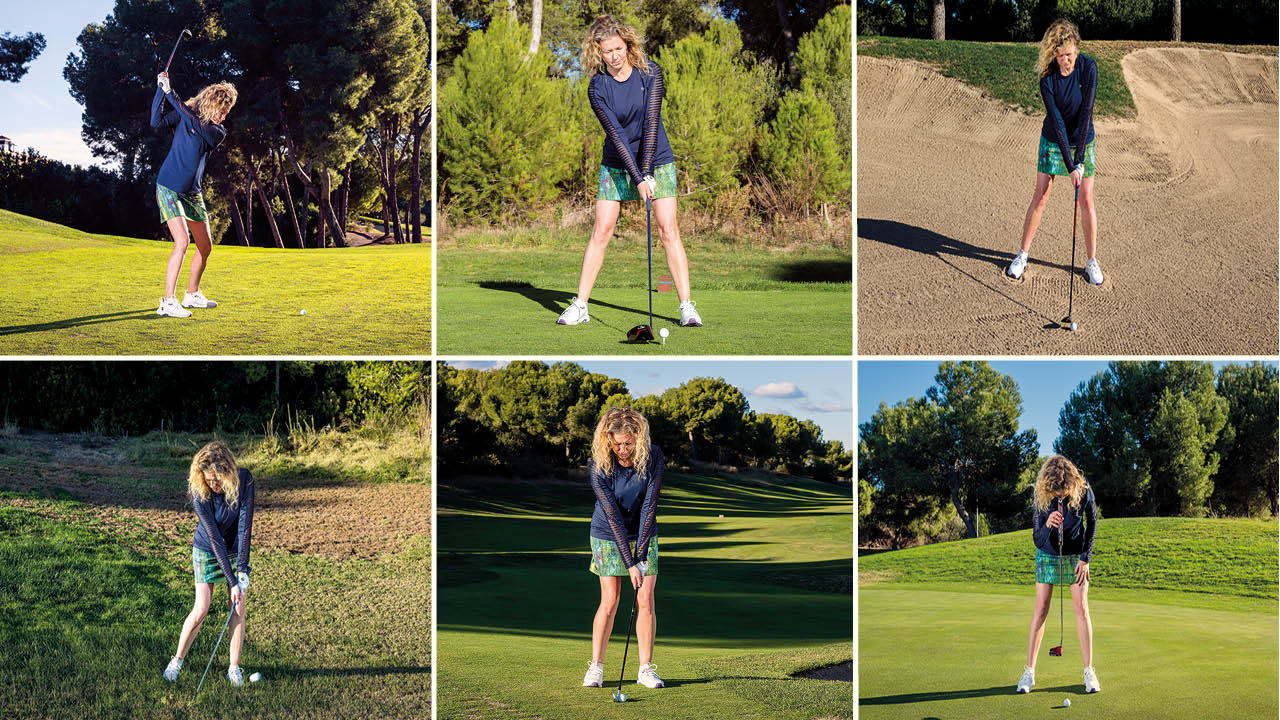
The position of the ball in your stance is often seen as the simplest part of the set-up in golf, yet it is the most overlooked. Finding the perfect ball position with every club is critical to making the correct contact and it should vary according to your shot selection and the scenario you face.
In this video, from Golf Monthly Top 50 Coach Peter Finch, and article by Golf Monthly Top 50 Coach Katie Dawkins, our experts explain the common mistakes golfers make and the simple corrections needed to successfully execute the various shots you’ll play during a typical round.
Perfect ball position with every club: The driver
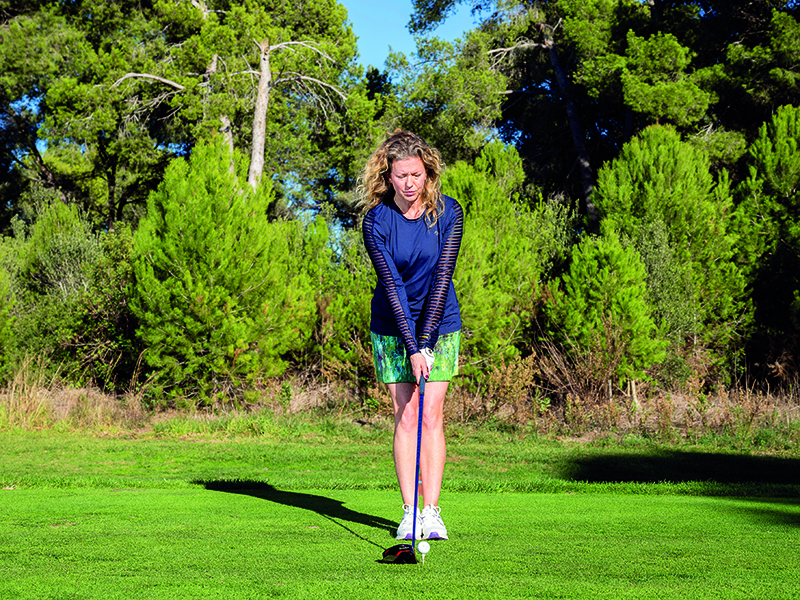
The ideal driver flight is one that launches high and carries far, and a lot of that comes down to the driver setup position. This ‘rainbow trajectory’ is best achieved using one the technology that is packed into of the best drivers on the market, with a big sweet-spot supporting your smooth technique.
Most amateurs struggle as they impart slice or hook spin on the ball, often due to poor ball position. Too far forward and the shoulders will open, causing you to cut across the ball and slice it. Too far back and you may end up skying your drives as your angle of attack becomes too downward.
The ideal ball position with a driver is just inside the left heel, allowing the club to sweep powerfully through the hitting area, collect the ball on the up and launch it high. To find the right ball position, start with both feet together then take a small step towards the target with your left foot and a big step away with your right.
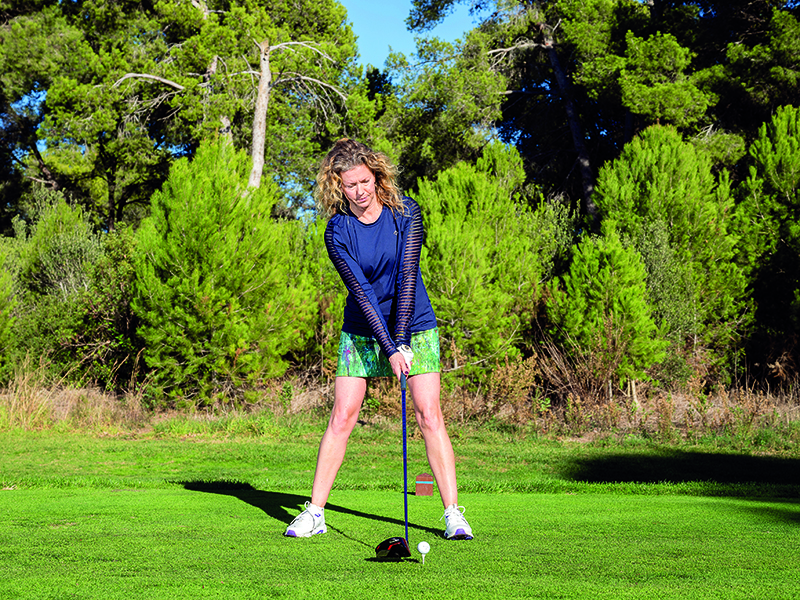
Fairway shots and awkward lies
Long-irons and hybrids
A common reason for golfers struggling to hit long shots into the green from the fairway is that they don’t adjust their ball position at set-up according to what club they’re playing. To hit a long-iron you need to position the ball just forward of centre in your stance.
Subscribe to the Golf Monthly newsletter to stay up to date with all the latest tour news, equipment news, reviews, head-to-heads and buyer’s guides from our team of experienced experts.
This will encourage the ideal ball-then-turf downward strike. Most golfers fail because they have the ball too far forward with their irons. Remember that an iron is designed to hit down on the ball so even your long shots can spin and stop.
The next problem I see comes when golfers select the wrong ball position for a hybrid. These clubs are essentially long-iron replacements, so you need to treat them the same as you would a long-iron and set up to them accordingly. Things usually go wrong when golfers use a ball position that’s too far forward in their stance, like you need to do with a fairway wood, although even then you shouldn’t have it as far forward as with a driver.
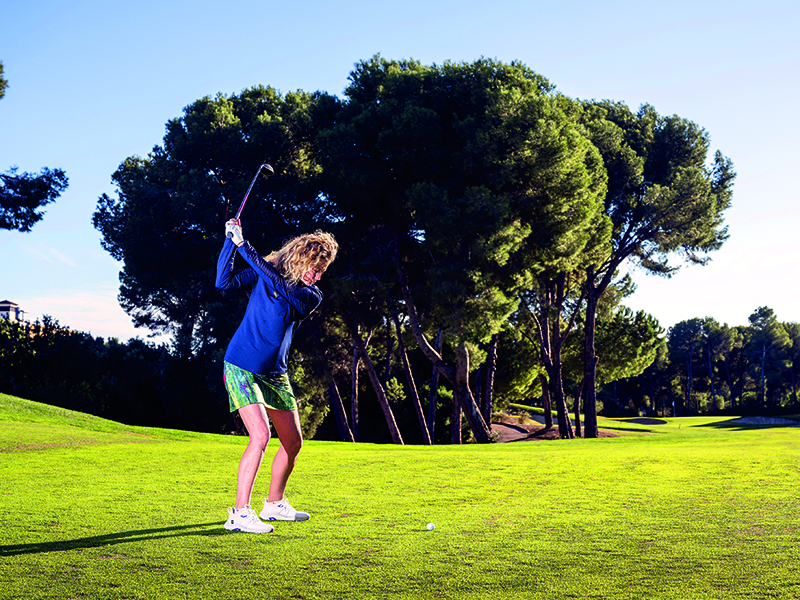
Escaping from the rough
When the ball is buried in deep rough, the right ball position is vital. Too far forward and all the club’s energy will be swallowed up by the deep grass and you won’t get it out, even with a very lofted club. Set the ball slightly back in your stance – a ball’s width back of centre is ideal for a wedge depending on how deep the rough is and how much the ball is buried.
Use a steep backswing and hit down hard into the rough with a hammer-style downward action. This driving force, combined with the right ball position, should let the club cut through the grass and pop the ball out.
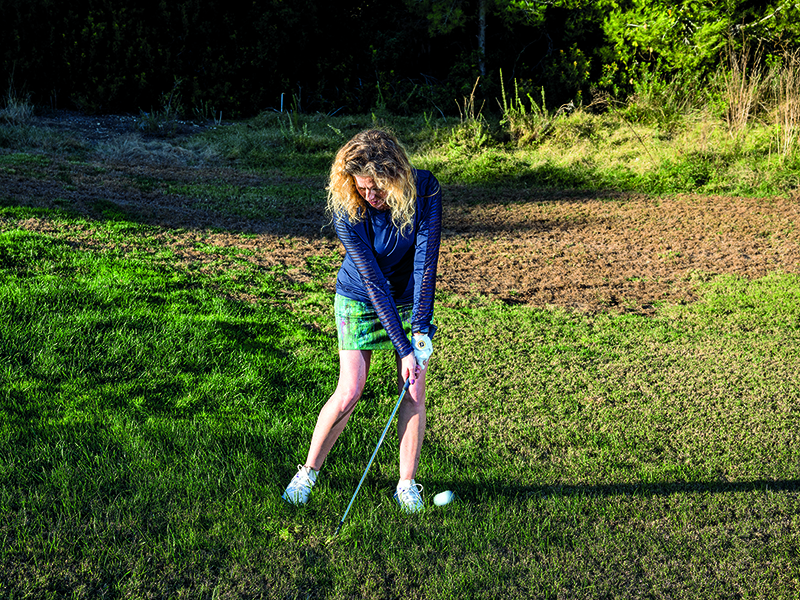
Ball above or below your feet
Success with the ball above or below your feet depends heavily on having the ball in the middle of your stance. With the ball below their feet, many golfers tend to set the ball too far forward. Instead, keep the ball position in the middle of your stance and increase your knee flex to lower your centre towards the ball. Try to maintain that exaggerated knee flex as you swing.
The ball being above your feet will encourage more of a flatter baseball-style action and having the ball in the centre of your stance will give you the best chance of making contact right in the centre of your swing arc.

Upslopes and downslopes
If you play on hilly courses, you’ll often face tricky stances. Most golfers struggle with upslopes and downlopes as they fight the slope and, in doing so, inadvertently have the ball too far back or forward.
The key is to make yourself at one with the slope by keeping your body angle perpendicular to it. A good mantra is ‘ball position up the slope, weight down the slope’. On downslopes, move the ball back in the stance a little and the weight forward and vice versa for upslopes. The extent of the adjustment depends on the severity of the slope.

Bunkers and chips
The fairway bunker shot
Many golfers dread fairway bunkers and fear not getting out. The common fault is the club catching the sand too soon, impacting into the surface before the ball. Catching the sand heavy will destroy your chances of getting distance and may even mean you fail to get out of the bunker.
The key to executing this shot successfully is to strike the ball before the sand. To do so you need a forward ball position – something similar to how you should set up to your driver, with the ball placed inside your left heel, half to one ball forward of where you would usually address an iron.
Hover the clubhead above the ball, not behind it. This is critical, as I want you to really focus on striking the ball cleanly before catching the sand. This hovered start point encourages a really clean contact.
Shuffle your feet into the sand to give you a stable base then add a little more grip pressure than usual. A tighter grip will stop you using too much wrist action, which can cause the club to bottom out into the sand early. Take a full backswing and focus on making that all-important clean contact with the ball.
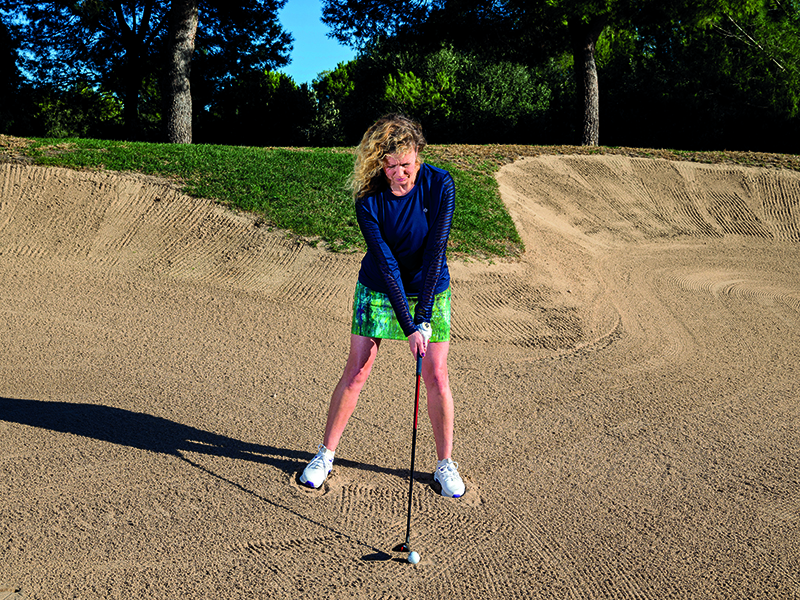
Plugged ball in the bunker
A plugged bunker lie can instil panic and the wrong ball position can certainly lead to disaster. But there is a way out and the key is to ‘blast’ it, taking plenty of sand first. You’ll need the ball much further back – around a one to one-and-a-half ball’s width further back of centre than for a standard splash shot.
Close the clubface, too, so it acts like a blade to slice through the sand, then grip down a touch lower to help with control. Now address the ball and shuffle your feet down deep, with your weight favouring the front foot as you need to pick the club up steeply with exaggerated wrist hinge and then hit down into the sand behind it with a steep chopping action. Don’t be afraid to hit down hard. The more power the better. The aim is to really blast the ball out on a bed of sand.
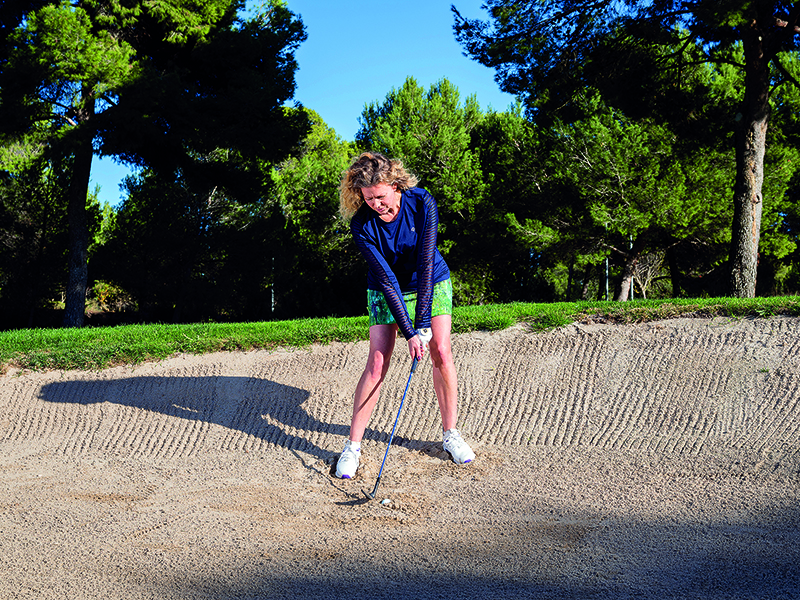
The chip shot
Many players go wrong with the simple chip shot because their ball position is incorrect – quite often too far back. From here, you risk hitting it heavy as you’re presenting too much of the leading edge to the turf.
Stand with your feet closer together and your left toes fanned out a touch towards the target and set the ball in the centre. Grip down towards the bottom of the shaft for control and let your weight favour the front foot. With the ball in the centre of your stance, the club should bruise the turf using the bounce and ‘collect’ the ball at the bottom of the arc.

Long chip and run shot
There will be many times during a round when you face a chip shot from quite a long way out. Maybe you need to run the ball all the way up a large green and it’s just too far to putt it. The key to executing the chip and run successfully is to change absolutely nothing about the set-up from that which you’ve just mastered for the basic chip shot. All you need to do is change the club you use.
Rather than using a lofted wedge, try a 7- or 8-iron. Then I want you to keep the same narrow stance, weight favouring the forward foot, and the ball positioned right in the centre. Far too often I see golfers move the ball forward when chipping with a longer club and trying to address it like a full shot. This will lead to the club bottoming out behind the ball and poor contact.
The longer the chip shot, the less loft you need on the club. You can use any club to play this shot, so don’t be afraid to experiment with your long-irons for added roll-out distance.
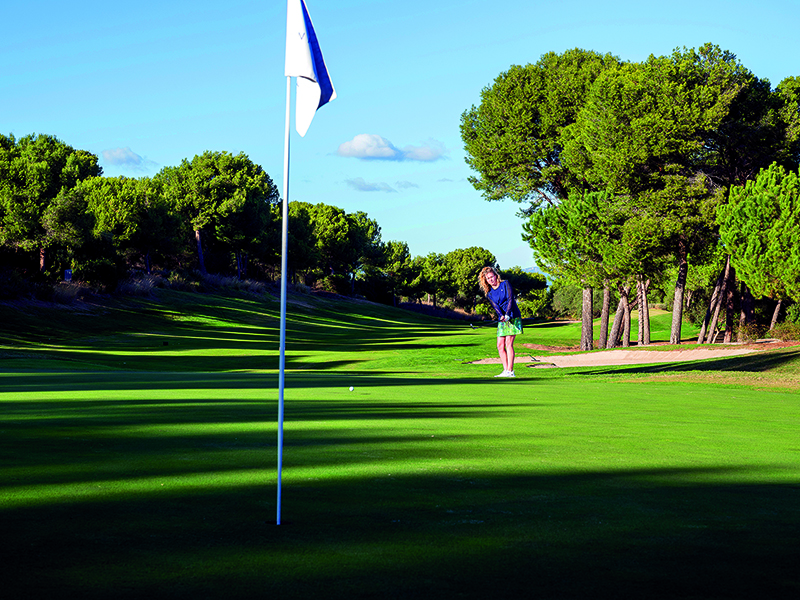
The putter
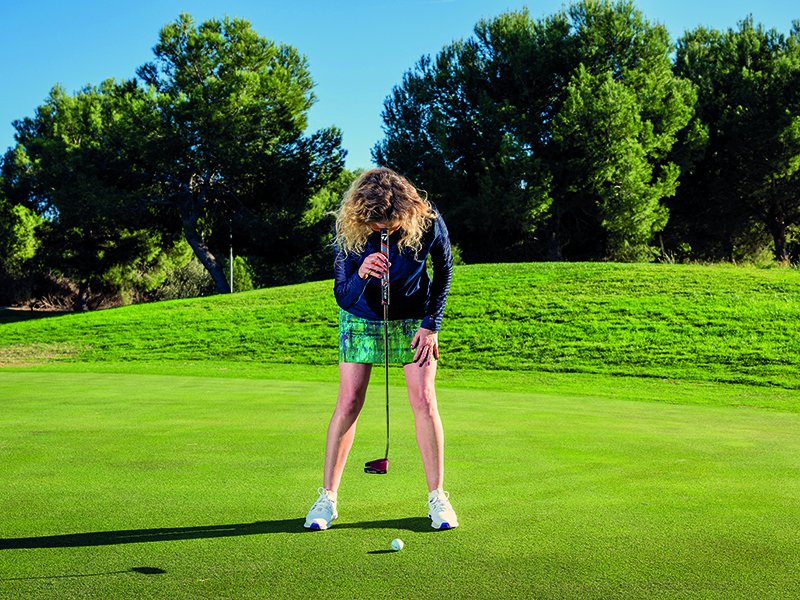
Ball position for a putt
There are many different styles of putting but the one thing critical to smooth, ‘true ball roll’ success is the position of the ball in your stance. Many golfers who ask for putting tips tell me they’re very inconsistent on the greens, with the ball seeming to jump or bump across them. The problem stems from a poor set-up. With the ball too far back in your stance, the putter will hit down on the putt, not up, causing it to skid before rolling out.
The optimum ball position for a putt is just forward of centre in your stance. This encourages a true ball roll-out. But if the ball is too far forward, it will open your shoulders up, causing you to pull putts left across the path. From the ideal ball position just ahead of centre, the putt will be struck just slightly on the up, encouraging the ball to start rolling immediately end-on-end.
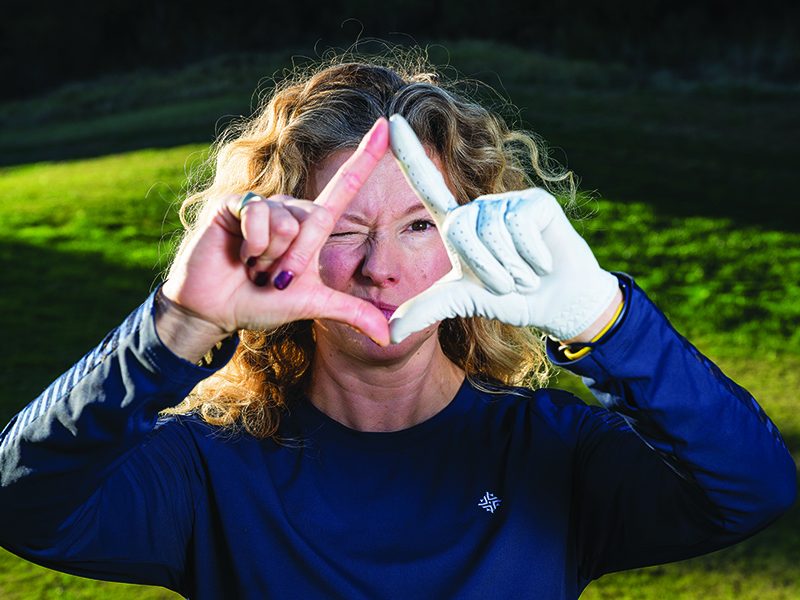
The dominant eye test
We miss more putts due to poor alignment – the difference between where we think we’re aiming and where we are – than poor mechanics. If you don’t line up correctly, you’ll end up making compensations in your stroke. We all have one dominant eye and knowing which it is can determine the ideal ball position to see the line of a putt properly.
To find out which, make a triangle with fingers and thumbs a little way in front of you. With both eyes open, centre the triangle on an object in the distance. Close your right eye. If the object stays centred, your left eye is dominant. If the framed object is no longer framed, your right eye is dominant.
Your dominant eye should be over the ball, so if you’re right eye-dominant, having the ball a touch further back than suggested should help you see the line of a putt better.

Katie is an Advanced PGA professional with over 20 years of coaching experience. She helps golfers of every age and ability to be the best versions of themselves. In January 2022 she was named as one of Golf Monthly's Top 50 Coaches.
Katie coaches the individual and uses her vast experience in technique, psychology and golf fitness to fix problems in a logical manner that is effective - she makes golf simple. Katie is based in the South of England, on the edge of the New Forest. An experienced club coach, she developed GardenGOLF during lockdown and as well as coaching at Iford Golf Centre, The Caversham- Home of Reading Golf Club and Salisbury & South Wilts Golf Club.
She freelances, operating via pop-up clinics and travelling to clients homes to help them use their space to improve.
She has coached tour pros on both LET tour and the Challenge Tour as well as introduced many a beginner to the game.
Katie has been writing instructional content for magazines for 20 years. Her creative approach to writing is fuelled by her sideline as an artist.
Katie's Current What's In The Bag
Driver: TaylorMade Qi10 9degrees.
Fairway: TaylorMade Qi10 5wood
Hybrid: TaylorMade 4 & 5
Irons: TaylorMade 770 6-AW
Wedges: TaylorMade Tour Grind 4 54 & 58
Putter: TaylorMade Tour X 33"
Favourite Shoes: FootJoy HyperFlex with Tour Flex Pro Softspikes on the course.
- Carly CumminsGolf Monthly Contributor

